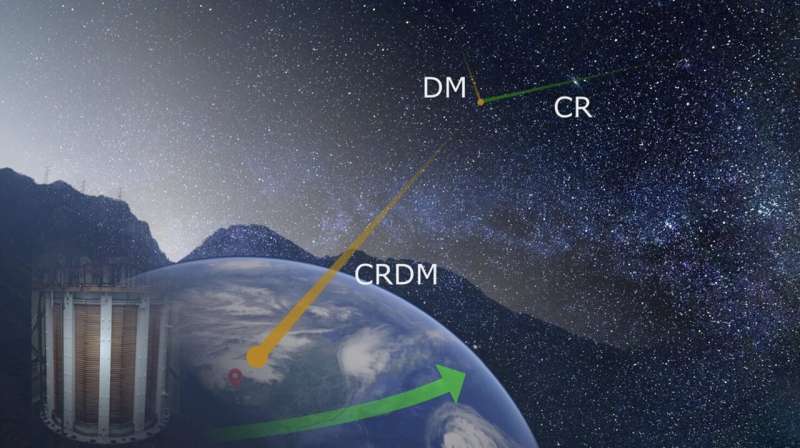Illustration of diurnal modulation signature of cosmic-ray boosted dark matter. Credit: Panda X-II Collaboration.
Physicists worldwide are continuing their search for dark matter, an elusive type of matter that does not absorb, reflect or emit light and is believed to make up most of the matter in the universe. A type of dark matter that many teams have been specifically looking for is sub-GeV dark matter, dark matter particles with masses below GeV (giga-electron volt).
The PandaX-II collaboration, a large team of researchers working at different institutes and universities in China, has recently carried out a search for cosmic-ray boosted dark matter, using data collected by the PandaX-II detector, located at the China Jinping Underground Laboratory. Their results, published in Physical Review Letters (PRL), broaden the probed parameter space for dark matter to masses from 0.1 MeV to GeV.
"Light dark matter, with mass smaller than the proton mass, was usually not probed in direct detection since it cannot produce large enough nuclear recoil to exceed detector's threshold," the researchers told Phys.org, via email. "Fortunately, the light dark matter particles in space can be kicked by cosmic rays to have relativistic speed. This allows them to overcome the direct detection threshold as first pointed out by researchers Torsten Bringmann and Maxim Pospelov."
In their recent study, the PandaX-II collaboration specifically looked at the diurnal modulation signal of dark matter that is "boosted" by cosmic rays. To do this, they analyzed the data collected by the PandaX-II detector in the experiment's latest trial.
Their analyses built on one of their previous phenomenological papers, published in early 2021 in PRL. In this previous work, the team had noticed, for the first time, that cosmic ray-boosted dark matter primarily originating from the core of our galaxy had a unique modulation signature.
"Dark matter travels a certain distance inside Earth before reaching the detector, which drastically varies from 2 km to 13000 km, depending on Earth's rotation," the researchers said. "The longer the distance, the stronger the attenuation effects."
Based on their observations, the PandaX-II collaboration realized that a combination of the distance that dark matter traveled inside Earth and its attenuation effects led to a unique diurnal modulation. In their new study, they thus set out to experimentally search for this diurnal modulation, by analyzing real data gathered by the PandaX-II experiment.
"We used the full data, for a total of 100 ton day, collected by the PandaX-II experiment in the China Jinping Underground Laboratory," the researchers explained. "In addition to the unique sidereal time, we also considered the characteristic high recoil energy distribution of the events. These two distinct features are used to suppress background and improve the signal sensitivity."
First, the team made a series of theoretical considerations. Specifically, they carefully considered the distributions of dark matter and cosmic rays in our galaxy, using a series of theoretical models.
"We modeled the propagation of dark matter in the Earth using a full Monte Carlo simulation method, including a detailed Jinping Mountain profile," the PandaX-II collaboration said. "To avoid the systematic uncertainty associated with incoherent and inelastic scattering through the Earth, we set an energy cutoff at 200 MeV, leading to a conservative and robust exclusion."
The recent analyses conducted by this team of researchers could significantly contribute to the search for sub-GeV dark matter. In fact, their results significantly extend the probed parameter space for dark matter from 0.1 MeV to GeV, covering a crucial type of dark matter-nucleon interactions that was previously inaccessible to astrophysical and cosmological probes.
Using the same experimental setup and datasets employed in their previous analyses, the team managed to gather additional insight, ultimately extending the "territory" explored by experiments aimed directly detecting dark matter. The PandaX collaboration is now conducting a new experiment, known as the PandaX-4T experiment. The team plans to carry out further analyses on the newly collected data.
"This new experiment is expected to improve the exposure by more than an order of magnitude and to significantly reduce the background," the researchers added. "In our next studies, we will use the new data to further improve the sensitivity of light dark matter detection by means of the cosmic-ray-boosting mechanism. We will also actively seek unique channels to maximally use our data to search for new physics phenomena in general."
More information: Xiangyi Cui et al, Search for Cosmic-Ray Boosted Sub-GeV Dark Matter at the PandaX-II Experiment, Physical Review Letters (2022). DOI: 10.1103/PhysRevLett.128.171801
Shao-Feng Ge et al, Diurnal Effect of Sub-GeV Dark Matter Boosted by Cosmic Rays, Physical Review Letters (2021). DOI: 10.1103/PhysRevLett.126.091804
Torsten Bringmann et al, Novel Direct Detection Constraints on Light Dark Matter, Physical Review Letters (2019). DOI: 10.1103/PhysRevLett.122.171801
Journal information: Physical Review Letters
© 2022 Science X Network
























